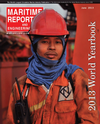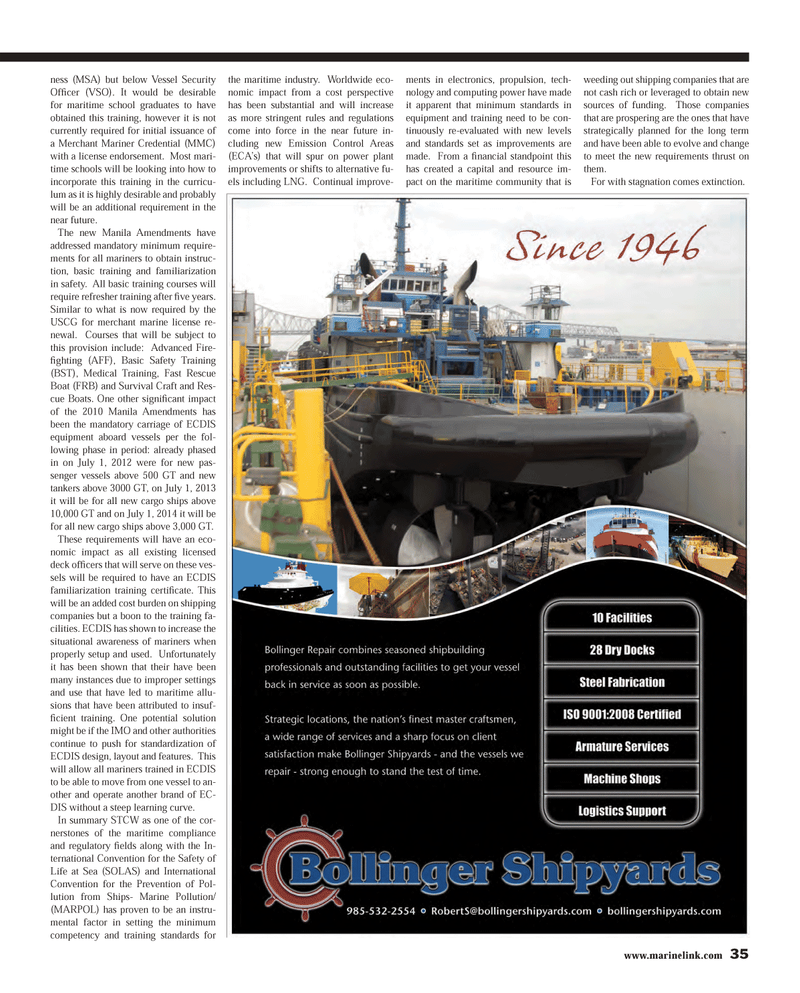
Page 35: of Maritime Reporter Magazine (June 2013)
Annual World Yearbook
Read this page in Pdf, Flash or Html5 edition of June 2013 Maritime Reporter Magazine
ness (MSA) but below Vessel Security OfÞ cer (VSO). It would be desirable for maritime school graduates to have obtained this training, however it is not currently required for initial issuance of a Merchant Mariner Credential (MMC) with a license endorsement. Most mari-time schools will be looking into how to incorporate this training in the curricu-lum as it is highly desirable and probably will be an additional requirement in the near future. The new Manila Amendments have addressed mandatory minimum require-ments for all mariners to obtain instruc-tion, basic training and familiarization in safety. All basic training courses will require refresher training after Þ ve years. Similar to what is now required by the USCG for merchant marine license re-newal. Courses that will be subject to this provision include: Advanced Fire- Þ ghting (AFF), Basic Safety Training (BST), Medical Training, Fast Rescue Boat (FRB) and Survival Craft and Res-cue Boats. One other signiÞ cant impact of the 2010 Manila Amendments has been the mandatory carriage of ECDIS equipment aboard vessels per the fol-lowing phase in period: already phased in on July 1, 2012 were for new pas-senger vessels above 500 GT and new tankers above 3000 GT, on July 1, 2013 it will be for all new cargo ships above 10,000 GT and on July 1, 2014 it will be for all new cargo ships above 3,000 GT. These requirements will have an eco-nomic impact as all existing licensed deck ofÞ cers that will serve on these ves- sels will be required to have an ECDIS familiarization training certiÞ cate. This will be an added cost burden on shipping companies but a boon to the training fa-cilities. ECDIS has shown to increase the situational awareness of mariners when properly setup and used. Unfortunately it has been shown that their have been many instances due to improper settings and use that have led to maritime allu-sions that have been attributed to insuf-Þ cient training. One potential solution might be if the IMO and other authorities continue to push for standardization of ECDIS design, layout and features. This will allow all mariners trained in ECDIS to be able to move from one vessel to an-other and operate another brand of EC-DIS without a steep learning curve.In summary STCW as one of the cor- nerstones of the maritime compliance and regulatory Þ elds along with the In- ternational Convention for the Safety of Life at Sea (SOLAS) and International Convention for the Prevention of Pol-lution from Ships- Marine Pollution/(MARPOL) has proven to be an instru-mental factor in setting the minimum competency and training standards for the maritime industry. Worldwide eco- nomic impact from a cost perspective has been substantial and will increase as more stringent rules and regulations come into force in the near future in-cluding new Emission Control Areas (ECA?s) that will spur on power plant improvements or shifts to alternative fu-els including LNG. Continual improve-ments in electronics, propulsion, tech-nology and computing power have made it apparent that minimum standards in equipment and training need to be con-tinuously re-evaluated with new levels and standards set as improvements are made. From a Þ nancial standpoint this has created a capital and resource im-pact on the maritime community that is weeding out shipping companies that are not cash rich or leveraged to obtain new sources of funding. Those companies that are prospering are the ones that have strategically planned for the long term and have been able to evolve and change to meet the new requirements thrust on them. For with stagnation comes extinction.www.marinelink.com 35MR #6 (34-41).indd 35MR #6 (34-41).indd 355/30/2013 1:03:28 PM5/30/2013 1:03:28 PM

 34
34

 36
36
